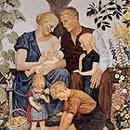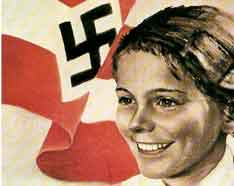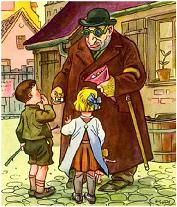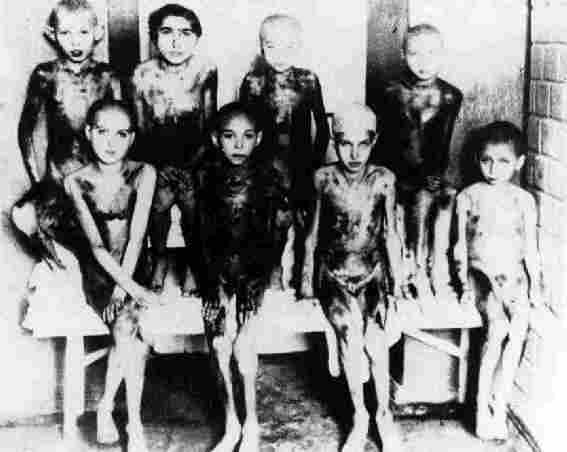|
       
Volksgemeinschaft – a national community
|
|
|
For Hitler and the Nazis, Nazi rule involved
the re-making of German society into a Volksgemeinschaft – a 'people's community' based on race,
proper
behaviour and Nazi principles. If not embraced willingly, this society
would be imposed by force. It would be ordered around an Aryan Herrenklasse ('master race'),
and would exclude anyone considered racially, biologically, politically, or socially unacceptable:
'There will be a
Herrenklasse', he said, 'an historical class tempered by battle, and welded from the most varied elements.
There will be a great hierarchy of party members; they will be the new middle class.
And there will he the great mass of the anonymous, the serving collective. Nor will their financial or previous social position
be of the slightest importance. These preposterous differences will have been liquidated in a single revolutionary process.
But beneath them there will still be the class of subject alien races; we need not hesitate to call them the modern slave class.
And over all of these will stand the new high aristocracy, the most deserving and the most responsible Fuhrer-personalities.'
Hermannn Rauschning (1939), decribing 'table-talk'comments by Hitler
You need to be careful with this source. Originally a Nazi supporter,
Rauschning fell out of favour and fled to America,
where he attacked Hitler's
dictatorship, so there may be an element of revenge; however, these comment are
in line with other things Hitler said.
|
Going Deeper
The following links will help you widen your knowledge:
Simple
overview
Simple pages from my KS3 series
 Dr Dennis's model answers
on a number of issues - really helpful Dr Dennis's model answers
on a number of issues - really helpful
Nazi Culture - excellent notes from Save My Exams
Podcasts
 - BBC debate-podcast on Life in Nazi Germany - BBC debate-podcast on Life in Nazi Germany
 - Scott Allsop's podcast on Life in Nazi Germany - Scott Allsop's podcast on Life in Nazi Germany
 - Giles Hill on Nazi Germany - Giles Hill on Nazi Germany
YouTube
Hitler's Germany - BBC 20thC History
Life in Nazi Germany - excellent History File video.
Pete Jackson on how lives changed under the Nazis
|
How did Nazi rule affect Germans?
[NOW YOU]
The key here is to understand that the Nazi state affected different people in different ways.
For the majority of people, in fact, life was good – that is why they turned a blind eye to the fact that – for groups which were not accepted by the Nazi state – life was
horrific.
1. Nazi Party
members
|
Source A
From 1933 onwards, the German people clearly conformed with the Nazi regime and
became devoted to Hitler. Hundreds of thousands of Germans from different classes
joined the Nazi Party. In fact, so many people tried to join in 1933 that the Party
struggled to cope with the numbers. In the years 1933–39, the Nazi Party gained four
million new members. A flood of people also joined other Nazi organisations.
The increase in support for the Nazis suggests that the majority of the German
people found it easy to support the Nazi dictatorship. From Backing Hitler: Consent and Coercion in Nazi Germany by R Gellately,
published in 2001.
Source B
We all felt the same, the same happiness and joy. Things were looking up. I believe no statesman has ever been as loved as Adolf Hitler was then. It’s all come flooding back to me. Those were happy times.
A German farmer, Luise Essig, remembering life in Nazi Germany.

Prora holiday camp
|
2. Ordinary people
For
ordinary people, life was good, and many Germans even today
look back and remember the years before 1939 as happy years:
-
Nazi
economic policies gave full
employment (work programmes/ Strength through Joy), prosperity and financial security - many observers stated
that there seemed to be no poverty in Germany,
-
the
Strength through Joy
programme (KdF) gave some
people trips away and cheap holidays.
-
the 'Beauty of Work' movement (SdA) gave
people pride in what they were doing.
-
law
and order (few people locked their doors),
-
autobahns
improved transport,
-
frequent
ceremonies, rallies, colour and excitement,
-
Nazi
propaganda gave people hope,
-
Nazi
racial philosophy gave people self-belief
-
Trust
in Adolf Hitler gave a sense of security (one German woman
told the American reporter Nora Wall: 'He is my mother and
my father. He keeps me safe from all harm.')
There
were some drawbacks:
-
Wages
fell, and strikers could be shot – the Nazis worked
closely with the businessmen to make sure that the
workforce were as controlled as possible.
-
Loss
of personal freedoms (eg freedom of speech).
-
All Culture had to be German - eg music had to be Beethoven
or Wagner or German folk songs – or Nazi – eg all actors
had to be members of the Nazi party/ only books by
approved authors could be read.
|
3. Women
Source C
Hitler was very clear that women should bring up children at home while their
husbands worked. Schools taught girls from a young age that all good German
women should get married and have children. 800,000 couples accepted loans
offered as part of the Law for the Encouragement of Marriage.
Women were not expected to work in Nazi Germany. Within months of Hitler coming
to power, many female doctors and civil servants were sacked, followed by female
teachers and lawyers.
By 1939, very few women were in full-time work.
From The History Learning Site, a history website.
The Nazis aimed to align women’s identity and activities with the regime’s racial and ideological goals. Nazi
philosophy held up women as vital to Germany’s national regeneration into the
Volksgemeinschaft – the bearers of Aryan children and defenders of the traditional family values. They sought to attract working-class and lower-middle-class women through promises of social stability, support for large families and, above all, adoration of Hitler:
-
The
Law for the Encouragement of Marriage gave newly-wed
couples a loan of 1000 marks, and allowed them to keep 250
marks for each child they had.
-
Mothers
who had more than 8 children were given a gold medal.
-
Women's organsations 'voluntarily'
disbanded and were replaced by the Deutsches Frauenwerk
('German Women's Work') and the NS-Frauenschaft
('Nazi Women's Group' – the women's wing of the Nazi
Party), which had 3½ million members by 1938.
But at the same time the Nazis were very male-dominated
and anti-feminist:
-
Girls education was changed – Science
and Latin were replaced by Domestic Skills, and girls were
discouraged from going to university (the Nazis tried,
unsccessfuly, to restrict female university enrollment to 10%).
-
Job-discrimination
against women was encouraged. Women doctors,
teachers and civil servants were forced to give up their
careers.
-
Women
were never allowed to serve in the armed forces – even
during the war.
Not all women were happy with the Nazi regime, but few women openly opposed it.
|
BBC Bitesize on Nazi policies towards women

The perfect Nazi family.
|
4. Youth
Most
German young people were happy:
-
Nazi
culture was very youth-oriented.
-
The
HJ provided exciting activities for young
boys.
-
The
HJ and the
BDM treated young men and women as though they
were special, and told then they had knew more then their
parents.
-
Many
parents were frightened that their children would report
them to the Gestapo, which gave young people a power
that they enjoyed.
But
not all young people were happy with the Nazi regime:
-
SOME
girls were unhappy with the emphasis on the three Cs
(Church, children, cooker).
-
Girls who were
regarded as true Aryan girls were sent off to special
camps where
they were bred (like farm animals) with
selected 'Aryan' boys.
-
In Germany, you could leave school at 14, and did not go for national service until you were 17, with the result that large numbers of rebellious 14-17-year-olds who rejected the HJ and Nazi propaganda and youth culture formed counterculture groups such as the
Swingjugend
(Swing Youth), the
Edelweißpiraten
(Edelweiss Pirates) and the
Leipzig Meuten (Leipzig Packs).
Until the War, the Swingjugend and Edelweißpiraten were regarded as scandalous rather than dangerous;
the Leipzig Meuten, by contrast, were arrested in 1938-39, with
many sent to youth prisons or reformatories.
|
BBC Bitesize on Nazi policies towards the young
More sources
on Nazi youth
 
The perfect Nazi boy ... and Aryan girl.

Edelweiss Pirate Barthel Schink, 17, wearing his edelweiss
flower badge.
|
5. Opponents
The Nazis
used 'fear and horror' against anyone who disapproved of their
regime:
-
Hitler
banned all Trade Unions on 2 May 1933. Their offices were closed, their money
confiscated, and their leaders put in prison.
-
Communists
were put into concentration camps or killed.
-
The Catholic and Protestant Churches
were persecuted, and the
clergy imprisoned.
-
Each
block of flats had a 'staircase ruler' who reported
grumblers to the police – they were arrested and either
murdered, or sent to concentration camps.
-
Children
were encouraged to report their parents to the Gestapo
if they criticized Hitler or the Nazi party.
But
remember that:
|
BBC Bitesize on Opposition and resistance
Nazi concentration camp badges
|
6. Untermensch
The Nazi regime despised
many groups which it thought were racially or socially inferior (Untermensch = subhuman) – people they called the 'germs of destruction'.
A main architect and enforcer of the Nazi's racial theories was
Heinrich Himmler.
Many Germans approved of this racism, or turned a
'blind eye'.
The Nazi regime was from the start based on anti-semitism:
The Racial Purity Law (15 September 1935) took away German citizenship
from the Jews, and forbade sex between Germans and Jews.
Other
key actions included the
boycott of Jewish shops,
Kristallnacht
(9-10 November 1938).
-
Forced emigration was introduced in 1938 under the Reich Central Office for Jewish Emigration,
and until 1941, German Jews with resources could emigrate voluntarily – half of Germany’s Jewish population left before the
War.
During the War the persecution
intensified: the Jews were forced into walled
ghettos,
put into concentration camps, and used for medical
experiments. At the Wansee Conference (January 1942) the Nazis devised the Final Solution of genocide – the
Holocaust.
Other groups
which were persecuted and killed included:
-
Gypsies were treated almost as badly as the Jews
– 85% of
Germany's gypsies were killed.
-
Black
Germans were sterilized and killed.
-
Some 6,000 Jehovah’s Witnesses were
convicted and sent to concentration camps, where about
1,000 died or were murdered.
-
Beggars,
homosexuals, prostitutes, alcoholics, pacifists,
hooligans and criminals were also regarded as
anti-social, and they were put in concentration camps.
The Nazis believed in 'eugenics' – that it was possible to eliminate certain disabilities by preventing those people from having children:
Physically
disabled people and families with hereditary illnesses
were sterilized; 300,000 men and
women were sterilized 1934-45. -
5000
mentally disabled babies were killed
1939-45.
-
72,000
mentally
ill patients were killed 1939-41.
-
Some
deaf people were sterilised or put to death.
- AQA-style Questions
4. Describe two problems facing Jews living in Germany during the years 1933 to 1939.
5. In what ways were the lives of women in Germany affected by Nazi social policies?
5. In what ways were the lives of young people affected by Nazi policies?
- Edexcel-style Questions
2. Explain
why so many ordinary Germans turned a blind eye to the Nazi atrocities.
3d. How far do you agree with
Source A about the extent of support for the Nazis in the years 1933-39?
3d. How far do you agree with Source C about Nazi policies towards women?
- OCR-style Questions
5. Describe one feature of the Nazis’ National Community.
6. Explain how the Nazis persuaded girls and women to fulfil traditional roles in the 1930s.
6. Explain why the Nazis persecuted some groups in Germany after 1933.
8. ‘The Nazis were successful in their aim of creating a National Community in Germany between 1933 and 1939’. How far do you agree?
-
iGCSE-style Questions
(b) Explain two effects of Nazi policies on young people in Germany, 1933-39.
• Explain two effects of the Nazis' persecution of the Jews.
(c) ‘The Nazis were genuinely popular in Germany in the years 1933–39’. How far do you agree? Explain your answer.
|
BBC Bitesize on the persecution of minorities
The persecution of the Jews -
essential link
 Nazi eugenics - BBC Witness History Nazi eugenics - BBC Witness History
YouTube
Pete Jackson on Society under the Nazis, focussing on Nazi racial policies

A Nazi race-hatred poster: "The Jew - the inciter of war, the prolonger of war".

Using negative images and stereotypes -
such as this illustration from
The Poisonous Mushroom
- Nazi propaganda pilloried Jews as dirty, deceitful, dangerous people of
whom Germany should be free.

Children in concentration camps who had been used for medical experiments.
|
    
|





